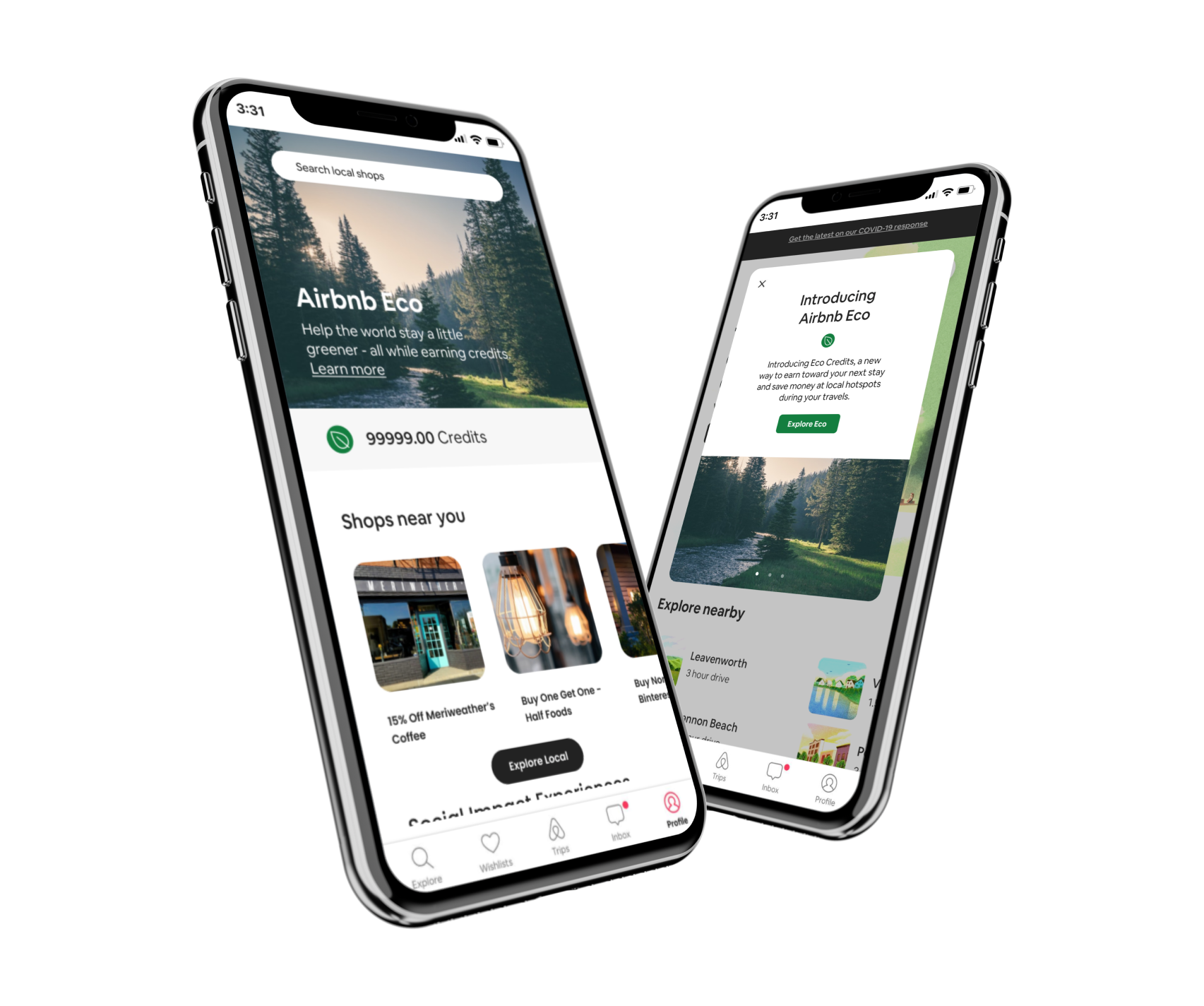AIRBNB ECO UX/UI
team
Amy Wisegarver , Daniel King, Jo Bloomfield, Alex Chang-Lam
DELIVERABLES
UX Research, UX/UI Design
BACKGROUND + Concept
As a part of my UX capstone class, we were challenged by Ryan Scott, the Design Lead at Airbnb, to produce a solution for the Airbnb app with the potential to decrease the environmental footprint of Airbnb guests. Over the course of the few weeks that we spent researching, designing, testing, and developing a prototype, we developed Airbnb ECO— a feature of the Airbnb app that encourages sustainability though eco-friendly stays and support of local businesses.
RESEARCH INSIGHTS
OVERVIEW
Before jumping to solutions, we needed to familiarize ourselves with the brand. We looked into what they currently had available to users, and how sustainability could be implemented into the guests experience. Another important aspect of research was understanding the market and what other companies were doing in the realm of sustainability.
COMPETITOR RESEARCH
After looking at other hospitality services and digital apps, Uber stood out as having a particularly solid plan for reaching zero-emissions. Other competitors offered little to guide guests to sustainable stays, and only a few made attempts to educate their audience on sustainability principles.
MARKET RESEARCH
While guests care about sustainability, it’s still “much less important to consumers than things like price, type of destination, convenience and amenities”. *
*Sources: aytm Sustainable Travel Survey, “How the Airbnb Community Support Environmentally Friendly Travel Worldwide” article, STR survey, Skift Travel Habits Survey
AIRBNB RESEARCH
Sustainable Travel Report from 2017 indicates that hosts are already doing a good job making their listings greener.
Interestingly enough, Airbnb also has a history of partnering with policymakers and NGO’s.*
*Sources: “Airbnb: Helping travel grow greener” report (2017), “How the Airbnb Community Support Environmentally Friendly Travel Worldwide” article
USER JOURNEYS
This portion of the research helped us re-expand and think of many different types of users. We discovered more pain points that we had previously overlooked. After branching off to complete this part of the research we reconverged and had some overlapping takeaways. This helped us reasses our previous ideas, and better understand how to move forward.
Doing user journeys from different perspectives taught us that the problem statement and overall airbnb experience is very different depending on the user’s goals and values. This helped us gain a familiarity of the Airbnb process and gave us a list of assumptions to validate through research.
USER FLOW
This portion of the research helped us re-expand and think of many different types of users. We discovered more pain points that we had previously overlooked. After branching off to complete this part of the research we reconverted and had some overlapping takeaways. This helped us reassess our previous ideas, and better understand how to move forward.
SKETCHES
Exploring what Airbnb app screens could look like including the Eco Credits. The placement of the leaf icon needed to be visible on many screens to help guide users, but unobtrusive to the current flow of the app.
WIREFRAMES
Wireframes testing the use of the “eco” icon and placement of credits earned from booking an eco stay. These wireframes were built based off of the current app’s information architecture.
After deliberating how to make the eco credits rewards available to users when shopping locally, we decided on QR codes. These codes would be pulled up by the user through the app, creating a familiar and quick digital interaction for users who already use coupons in this manner.
USER TESTING + RESULTS
UI prototype testing with users revealed several issues:
The small business aspect of the reward system was not entirely in line with users idea of Airbnb as a brand, in that it is a place to book stays or experiences and nothing more
Users rarely interacted with the bottom navigation tabs
Not all users read the initial description on what eco credits are
Informational tooltips would be helpful on multiple pages, such as search results
FINAL SOLUTION
Our final iteration retained both eco credits and small business reward integrations as the primary features. Users are able to earn the credits by booking participating stays and redeem those credits for the same. There are visual indicators of credit value on the search results, listing details, and booking pages, along with potential earnings as part of each listing. From the Airbnb Eco section users can view their current credit total as well as nearby paticipating businesses and additional information on the Airbnb Eco program.

















